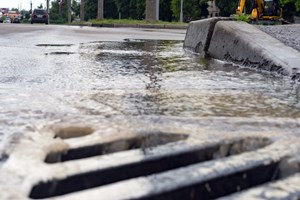Analysis: Laura Reminds of Louisiana’s Fragile Water Systems
BATON ROUGE, La. (AP) — Louisiana shouldn’t have needed a reminder about the fragility of its public water supply, with half the state’s water systems operating off structures that are more 50 years old and a national report card regularly declaring the state’s maintenance of its drinking water systems is barely above failing.
Still, Hurricane Laura’s devastating trip across southwest and into north Louisiana walloped water systems and could draw more attention to the poor infrastructure that parts of the state rely on for one of life’s most basic necessities.
In the hurricane’s immediate aftermath, the Louisiana Department of Health said 121 water systems suffered outages, leaving hundreds of thousands of people without water. Outages lasted for days, and several dozen system outages continue well after Laura roared ashore Aug. 27. Meanwhile, more than 150 water systems at one point have had disruptions from the storm that required people to boil their water for its safe use.
In the early days after Laura struck, more than 600,000 people across Louisiana either had no access to water or were under boil water advisories — creating widespread problems for evacuees trying to return home, even if their homes sustained only minor damage.
“I think it definitely brings to the forefront how important water is. You know, people take it for granted that when they turn on their taps that they have water,” said Amanda Ames, chief engineer for the Louisiana Department of Health overseeing water issues. “And then when they don’t, they realize, ‘I can’t flush my toilet. I don’t have fire protection.’ It almost makes things uninhabitable.”
Louisiana has about 1,300 water systems, Ames said. About 900 of those are community water systems that supply homes, neighborhoods and cities, while the others are for businesses, schools or other entities that operate their own independent water sources and systems, she said.
Gov. John Bel Edwards has tried to draw new attention to Louisiana’s struggling water systems, particularly those in rural areas that are teetering on the brink of catastrophic failures.
“Water is something we so often take for granted, and yet it is as essential to life as breathing,” the Democratic governor said in his 2019 address to state lawmakers.
That year, the House and Senate agreed to his push to establish a Rural Water Infrastructure Committee, to do a risk analysis of water systems, identify available state and federal resources for repairs, offer technical assistance to system operators and suggest ways to bring water systems not following regulations back in line.
The committee came after Edwards in December 2016 declared a public health emergency in the small northeast Louisiana town of St. Joseph and urged people not to use the water coming out of their taps because the state found elevated levels of lead and copper in the system.
The state trucked in water to residents while $8.6 million went into a new water treatment and distribution plant for St. Joseph. In March 2018, Edwards lifted the public health emergency.
St. Joseph’s water troubles were a warning about the risks of aging infrastructure, particularly in rural communities that no longer have the financial abilities to maintain the systems.
The state’s problems are extensive, according to an infrastructure report card issued by the American Society of Civil Engineers. The organization’s latest assessment in 2017 gave Louisiana a D-minus grade for its drinking water, similar to the prior report card issued five years earlier.
“Louisiana’s drinking water infrastructure is aging, and little is being done to replace or upgrade many of the current systems in place,” the engineers said in the report.
In a survey released a year later, the U.S. Environmental Protection Agency estimated Louisiana’s 20-year funding needs for drinking water infrastructure topped $7 billion.
Hurricane Laura’s destruction emphasized how important basic infrastructure, such as a functioning water system, is to home and businesses. It also may force some of the most heavily damaged systems to build stronger to meet updated regulations, while administrators of other water systems may simply find it wise to harden their infrastructure.
Ames said she hoped “if they did have issues that were directly correlated to failing infrastructure or old infrastructure, that they would take it upon themselves to try to bring their system into a newer day.”
Of course, even the best built systems aren’t necessarily made to withstand the powerful winds of a Category 4 hurricane.
Related News
From Archive

- Glenfarne Alaska LNG targets late-2026 construction start for 807-mile pipeline project
- U.S. water reuse boom to fuel $47 billion in infrastructure spending through 2035
- $2.3 billion approved to construct 236-mile Texas-to-Gulf gas pipeline
- Major water pipe break in Puerto Rico hits over 165,000 customers
- Potomac River Tunnel project enters construction phase beneath Washington, D.C.
- Pennsylvania American Water launches interactive map to identify, replace lead water service lines
- Trump's tariffs drive $33 million cost increase for Cincinnati sewer project
- Utah city launches historic $70 million tunnel project using box jacking under active rail line
- Tulsa residents warned after sewer lines damaged by boring work
- Fatal trench collapse halts sewer construction in Massachusetts; two workers hospitalized




Comments